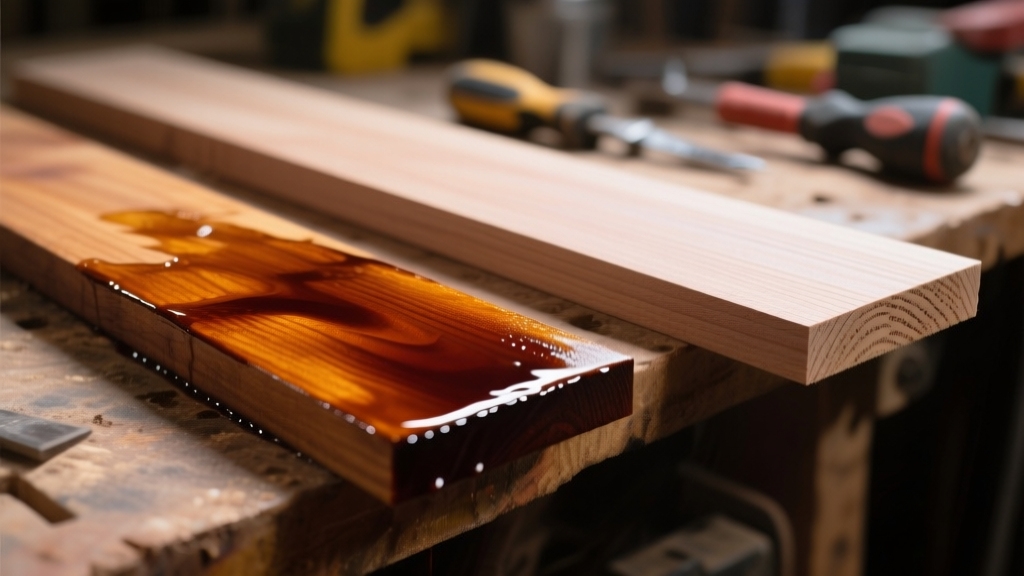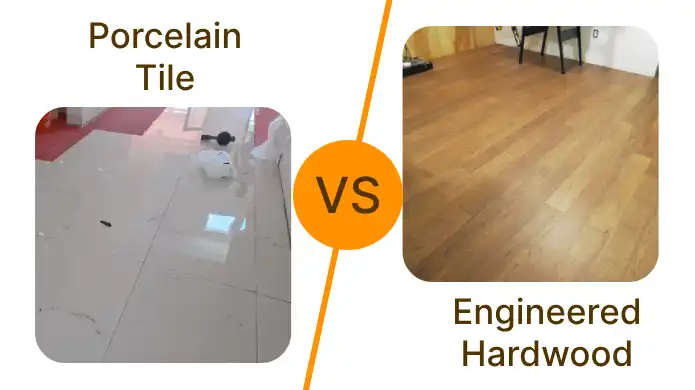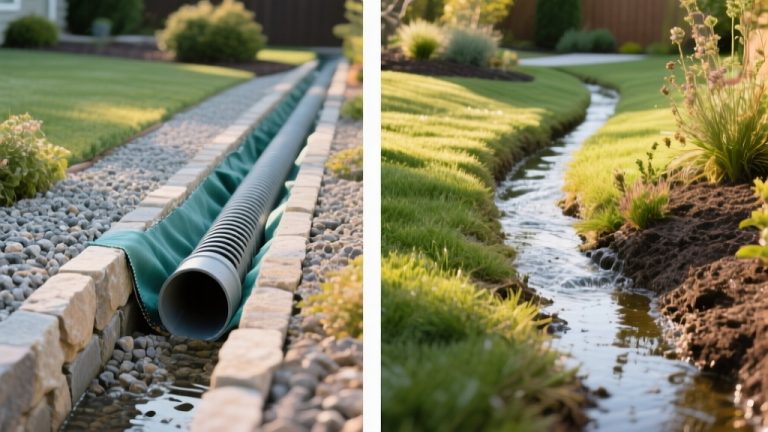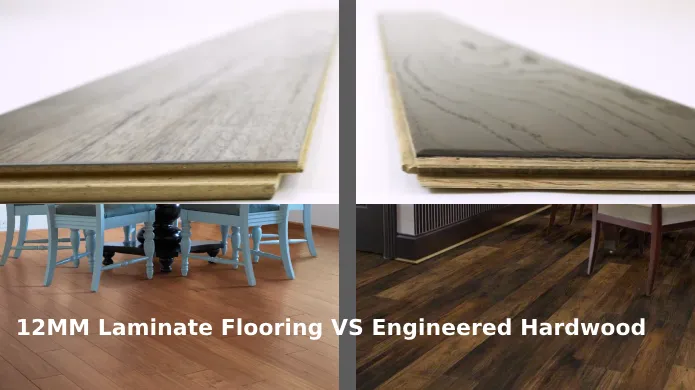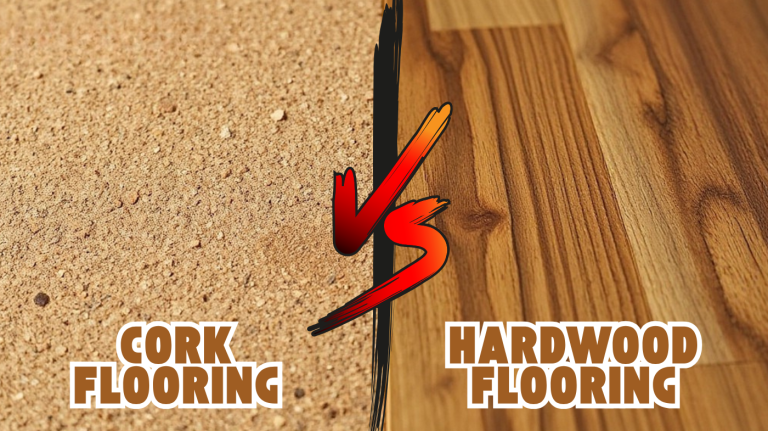Oil Stain vs Water Based Stain: Expert Tips & Comparison
You’ll find oil-based stains dry slower (8-48 hours) but penetrate deeply, offering superior durability, UV resistance, and rich, glossy finishes ideal for dense hardwoods and harsh outdoor environments.
Water-based stains dry fast (1-6 hours), are eco-friendly with low VOCs, easy to clean, and better suited for softer woods and interior use.
Each requires specific prep and conditions for best results. If you want to understand how these factors impact your project’s longevity and aesthetic, there’s more to explore.
- RICH EVEN COLOR – Minwax Wood Finish is a deep penetrating, oil-based wood stain that provides…
- QUICK DRYING – Staining interior wood has never been quicker. The special formula allows it to…
- EASY TO APPLY – Use a clean cloth or wood stain brush to apply this wood stain in the direction of…
- EFFECTIVE ON ALL WOOD SURFACES and QUICK DRYING: Furniture Clinic Wood Stain is a fast drying and…
- COMES IN 12 COLORS – VISIBLE WITH ONE COAT: Our wood stain comes in 12 colors ranging from dark to…
- COVERAGE: Available in three sizes to suit your needs, our 250ml bottle covers 3m², our 500ml…
Key Takeaways
- Oil-based stains penetrate deeply, offering superior durability, UV resistance, and water protection, ideal for outdoor and dense hardwood applications.
- Water-based stains dry quickly, have low VOCs, easy cleanup with soap and water, and are environmentally friendly with milder odors.
- Oil stains provide richer, deeper colors with longer working time, while water stains yield lighter, vibrant tones but may raise the wood grain.
- Oil stains tolerate colder, humid conditions and require mineral spirits for cleanup; water stains prefer warm, dry weather and clean up easily.
- Water-based stains are best for softer woods and interiors; oil-based stains excel on hardwoods and high-traffic outdoor areas due to better penetration and durability.
Oil Stain or Water Based Stain: Key Differences
| Feature | Oil-Based Stain | Water-Based Stain |
|---|---|---|
| Drying Time | 8-48 hours (slow drying allows blending) | 1-6 hours (rapid drying for quick projects) |
| Penetration | Deep penetration into wood fibers | Surface film with minimal penetration |
| Durability | Superior long-term protection, resists UV damage | Less durable, requires frequent maintenance |
| Finish Appearance | Rich, glossy, warm tones with grain enhancement | Lighter, matte to semi-gloss, vibrant colors |
| VOC Content | High VOCs, strong odor, health concerns | Low VOCs, mild odor, eco-friendly |
| Cleanup | Requires mineral spirits or turpentine | Simple soap and water cleanup |
| Best Wood Types | Dense hardwoods (oak, mahogany, walnut) | Softwoods (pine, cedar, poplar) |
| Ideal Use | Outdoor decks, fences, high-traffic areas | Interior projects, furniture, walls |
| Cost Range | $35-$120 per gallon (fewer coats needed) | $20-$90 per gallon (may need more coats) |
| Weather Resistance | Excellent moisture and UV resistance | Moderate resistance, better mold resistance |
| Application | Longer working time, easier blending | Quick application required to avoid blotching |
| Maintenance | Less frequent reapplication needed | More frequent touch-ups and maintenance |
Drying Time and Application Differences
Although water-based stains dry considerably faster, typically within 1 to 6 hours, allowing you to complete projects quickly. Oil-based stains require 8 to 48 hours to fully dry depending on environmental conditions.
Water-based stains dry by forming a surface film, which facilitates rapid curing and suits projects needing multiple coats or quick turnaround. However, this quick absorption can make achieving an even application challenging, especially on large surfaces or for less experienced users.
Modern high-tech resins in water-based stains penetrate as deep as oil-based stains, improving their performance. It is important to use proper cleaning techniques to maintain the finish after staining.
In contrast, oil-based stains penetrate deeply into wood fibers and dry slowly, giving you more time to blend and reduce streaks or lap marks for a uniform finish. Cleanup for water-based stains is simple with soap and water, while oil-based stains demand mineral spirits or turpentine due to their oil content.
Durability and Protective Qualities
Beyond drying times and application techniques, you’ll find significant differences in how oil-based and water-based stains protect and endure over time.
Oil-based stains penetrate deeply into wood fibers, creating a durable barrier that resists moisture, UV damage, peeling, and cracking. This deep penetration enhances their longevity, making them ideal for outdoor and high-traffic areas.
They also move with wood, accommodating expansion and contraction which reduces cracking and peeling. Proper maintenance, including post-cleaning care, helps prolong the protective qualities of oil-based stains.
In contrast, water-based stains mostly form a surface film that provides less internal protection. This makes them more susceptible to fading, peeling, and wear, especially under harsh weather conditions.
Because oil-based stains maintain integrity longer and require less frequent reapplication, they offer superior durability and protective qualities. Water-based stains demand more maintenance, including thorough surface prep for reapplication, limiting their long-term resilience compared to oil-based options.
Environmental and Health Considerations
When selecting a wood stain, you should consider the environmental and health impacts of its chemical composition and emissions.
Oil-based stains release high VOCs, toxic solvents, and hazardous waste, posing risks like respiratory irritation and environmental contamination. They are also derived from petroleum, which depletes non-renewable resources.
Additionally, improper cleaning of tools after use involves hazardous solvents that require careful disposal to avoid environmental damage.
Water-based stains emit low VOCs, have milder odors, and safer disposal, making them preferable for indoor and eco-conscious applications. Their easy cleanup with soap and water also reduces exposure to harmful chemicals and waste.
| Aspect | Oil-Based Stain | Water-Based Stain |
|---|---|---|
| VOC Content | High; significant air pollution | Low; minimal impact on air quality |
| Toxicity | Contains toxic chemicals | Lower toxicity and milder odors |
| Cleanup | Requires hazardous solvents | Soap and water; biodegradable |
| Environmental Impact | Pollutes soil/water, non-biodegradable | Reduced pollution, eco-friendly |
Choose water-based stains to minimize health risks and environmental harm.
Appearance and Finish Characteristics
Understanding the environmental and health impacts of oil-based and water-based stains is important, but you also need to contemplate how each affects the wood’s appearance and finish.
Oil-based stains penetrate deeply, producing richer, deeper tones that enhance wood grain visibility. They create a smooth, glossy surface with a traditional sheen. They are suitable for outdoor projects like fences, decks, and sheds due to their durable finish.
Additionally, oil-based finishes tend to provide longer curing times which allow for better penetration and protection.
In contrast, water-based stains yield lighter, more vibrant colors with clearer pigments that resist yellowing. They offer a cleaner, more uniform look. However, they form a surface film that can raise the grain, resulting in a matte to semi-gloss finish and may require extra sanding.
Water-based stains dry rapidly, demanding swift, precise application to avoid blotching. Oil-based stains provide longer working time, facilitating even blending and a flawless, durable finish.
Cost and Availability Factors
Several cost and availability factors influence your choice between oil-based and water-based stains.
Oil-based stains generally cost $35 to $120 per gallon and require fewer coats, potentially lowering total product use. They dry slowly (24+ hours), increasing labor costs but offer longer-lasting protection, reducing maintenance expenses.
Their ability to penetrate deeper into wood also contributes to their durability and rich appearance. Proper drying procedures and reapplying finish ensure the longevity of the wood’s protective surface.
Water-based stains range from $20 to $90 per gallon but may require more coats due to lower opacity, increasing material and labor costs despite faster drying (1–4 hours) and easier cleanup with soap and water. They benefit from using pH-neutral cleaners during maintenance to preserve the finish and prevent damage.
Both types are widely available, though water-based stains offer a broader color range but sometimes limited premium options regionally. Consider environmental factors: water-based stains have lower VOCs, reducing compliance costs, while oil-based stains’ flammability may increase insurance expenses.
Suitability for Wood Types and Weather Conditions
When it comes to choosing stains for your wood projects, it’s all about matching the right product with the wood type and the weather conditions you’ll face.
For instance, oil-based stains really shine when applied to dense hardwoods. They penetrate deeply, providing excellent weather resistance, making them a go-to choice for extreme conditions.
They also create an added moisture layer beneath the surface for enhanced protection, which is beneficial in harsh environments. Proper drying times are crucial with oil-based finishes to ensure durability and avoid damage during subsequent steps like painting or refinishing drying times.
On the other hand, if you’re working with softwoods, water-based stains are the way to go. They allow the wood to breathe and help prevent moisture from getting trapped, which is especially important in moderate climates.
Additionally, water-based stains dry quickly due to rapid evaporation, allowing for faster project completion. Using protective measures such as drop cloths during painting can help preserve the finish on water-based stained wood.
Wood Compatibility Differences
Although both oil-based and water-based stains serve to enhance wood surfaces, their compatibility varies markedly depending on wood type and environmental exposure.
Oil-based stains penetrate dense hardwoods like oak and mahogany deeply, enhancing grain and color longevity. Proper prep work before staining influences final appearance and quality, so pre-stain preparation is recommended regardless of stain type. They also provide better protection against water damage, which can cause soft spots and discoloration when untreated.
Water-based stains rest more on the surface, suiting softer woods such as pine and poplar that absorb quickly but may raise the grain.
To prevent blotchiness, you should use pre-stain conditioners compatible with the stain chemistry: oil-based conditioners for oil stains, water-based for water stains. Oil-based stains excel on woods prone to rot due to superior sealing.
Water-based stains better preserve fine grain woods’ natural appearance. Also, water-based stains often require extra sanding to manage raised grain, unlike oil-based stains that minimize this effect.
Weather Resistance Factors
When selecting a stain for outdoor wood, understanding how oil-based and water-based formulations resist weather elements is essential to preserving wood integrity and appearance.
Consider protective methods that avoid potential damage to the wood surface, such as avoiding aggressive adhesives that can cause surface scratches and discoloration.
Oil-based stains excel in UV protection and moisture resistance, penetrating deeply to shield wood from sun and rain damage. They also offer easy maintenance with simple annual reapplication. Water-based stains dry faster and resist mold better but may fade quicker and allow more moisture intrusion.
| Factor | Oil-Based Stain | Water-Based Stain |
|---|---|---|
| UV Resistance | Superior, maintains color longer | Weaker, fades faster unless UV-treated |
| Moisture Resistance | Deep penetration, water-repellent | Surface film, less effective barrier |
| Mold & Mildew | Can promote growth, needs maintenance | Resists growth, dries quickly |
| Application Weather | Tolerates cold/humidity | Requires warm, dry conditions |
| Wood Expansion | Moves with wood, reduces cracking | Less flexible, potential peeling |
Application Environment Guidelines
Understanding how oil-based and water-based stains perform under various environmental conditions helps you match the right product to specific wood types and weather scenarios.
Oil-based stains penetrate dense woods deeply, making them ideal for older decks and floors. However, they risk trapping moisture in loosely grained woods like teak. It is important to avoid excessive water exposure during the curing period to prevent water damage.
Water-based stains suit less dense woods such as cedar and redwood, providing a breathable finish and faster drying times. They also offer easy cleanup using just water and soap on brushes and tools, simplifying post-application maintenance.
Consider these for your application: Choose oil-based stains for high-traffic outdoor areas needing durable sealing. Opt for water-based stains in enclosed interior spaces due to low VOCs and minimal odor. Use water-based stains on outdoor furniture where grain raising isn’t critical and quick drying aids project speed.
Assess wood species, ventilation, and climate to optimize stain performance and longevity. Maintaining proper moisture control during and after application helps preserve the finish and prevents issues such as warping or peeling.
Frequently Asked Questions
Can Oil-Based and Water-Based Stains Be Mixed Safely?
You can’t safely mix oil-based and water-based stains directly because they chemically repel each other, causing separation and instability. Stirring won’t create a uniform product, and the resulting mixture won’t apply evenly or deliver the desired finish.
Instead, apply them in layers with proper drying time and surface prep to avoid adhesion issues. Mixing them in one container compromises performance and safety, so keep each type separate for best results.
How Long Should I Wait Before Applying a Sealant Over Each Stain Type?
You should wait at least 24 hours before applying a sealant over either stain type to guarantee proper drying and adhesion. Oil-based stains typically need about 24 hours to dry, with full curing up to 72 hours.
Water-based stains dry faster but still require a full day to avoid finish issues. Always confirm dryness by touch or light sanding and consider environmental factors like temperature and humidity that can affect wait times.
Are There Specific Tools Recommended for Applying Oil-Based Versus Water-Based Stains?
Yes, you should use natural bristle brushes and lambswool rollers for oil-based stains to guarantee even absorption and smooth application. For water-based stains, synthetic bristle brushes and foam rollers are ideal as they resist water damage and maintain shape.
Always match applicators to your stain type to prevent streaks or uneven layers. Clean oil-based tools with mineral spirits; clean water-based tools with soap and water for best results.
Which Stain Type Is Easier to Remove if a Mistake Is Made?
If you make a mistake, water-based stains are easier to remove because they dry quickly and clean up with just soap and water, allowing you to wipe off or correct errors promptly.
In contrast, oil-based stains penetrate deeply and require solvents or sanding for removal, making corrections more complex and labor-intensive.
You’ll find water-based stains less hazardous and more forgiving, while oil-based stains demand faster action and more intensive cleanup methods.
Do Oil-Based and Water-Based Stains Affect Wood Sanding Differently?
Yes, oil-based and water-based stains affect sanding differently. When you use oil-based stains, the wood penetrates deeply. You’ll do minimal sanding before recoating since the stain integrates well with the grain.
Water-based stains raise the wood grain due to their water content, requiring you to sand more thoroughly between coats to smooth the surface. Skipping sanding with water-based stains often leads to a rough, uneven finish. Proper sanding is vital.
Making the Right Choice: Oil Stain or Water-Based Stain
When choosing between oil stain and water-based stain, consider vital contrasts carefully. Oil stains offer slower drying but superior seepage and sturdy shielding, while water-based stains dry swiftly with safer, sustainable substances.
Appearance varies: oil imparts a warm, rich sheen; water highlights natural hues with a matte finish. Costs and compatibility differ too, depending on wood type and weather.
Balancing benefits and drawbacks lets you select the stain solution suited specifically to your project’s precise performance and protection needs.
- Ideal for use on all interior wood projects: furniture, cabinets, doors, trim and paneling
- One-coat coverage, fast-drying Oil based formula
- Dries to the touch in just 1 hour and covers up to 275 square feet
- 20 YEARS OF NORTH-AMERICAN EXCELLENCE: The preferred choice of professional woodworkers and DIYers…
- SAFE TO USE PRODUCT: Odorless and low VOC, risk free for health of the users, pets and the…
- HIGH-QUALITY PRODUCT: Protects and elevates wood’s beauty on all your renovation or decoration…
Last update on 2025-12-18 / Affiliate links / Images from Amazon Product Advertising API

